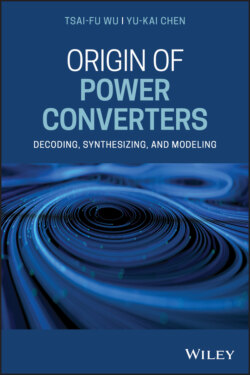Читать книгу Origin of Power Converters - Tsai-Fu Wu - Страница 18
1.2.2 PWM Power Converters
ОглавлениеPower transfer between a capacitor and an inductor can be modulated by a switch, as shown in Figure 1.5c, and their total electrical energy is always conserved to their initially stored energy. In the network, capacitor C1 limits the slew rate of voltage variation, inductor L1 limits that of current variation, and switch S1 controls the time interval of power transfer, i.e., pulse‐width modulation. Thus, component stresses can be properly controlled, and high conversion efficiency can be insured. Additionally, EMI level can be also reduced significantly. Power converter configurations based on this type of network are called PWM power converters. Note that it requires an additional freewheeling path when switch S1 is turned off, which will be discussed in later section. For simplicity while without confusion in power electronics area, the short‐form PWM converters or converters will be used to represent the PWM power converters. They have been widely applied to various types of power conversion for their controllable power transfer, theoretically no loss, and finite component stresses.
The minimum‐order network of a PWM converter is a second‐order LC network, and it must at least include a switch to control power flow. The order of network can be increased to third, fourth, and even higher. For a valid PWM converter, the network must be always in resonant manner at either switch turn‐on or turn‐off.
Over the past century, PWM converters have been well developed and have diversified configurations, such as buck, boost, buck‐boost, Ćuk, sepic, Zeta, flyback, forward, push‐pull, half‐bridge, full‐bridge, Z‐source, neutral‐point clamped (NPC), modular multilevel, quasi‐resonant, and LLC resonant converters. They can be classified into non‐isolated and isolated configurations. Typically, the isolated versions can be derived from the non‐isolated ones by inserting a DC transformer or an AC transformer to a proper location of the converter. Thus, we will first introduce non‐isolated converters, which can lay out a firm foundation for later discussions on isolated converters.
